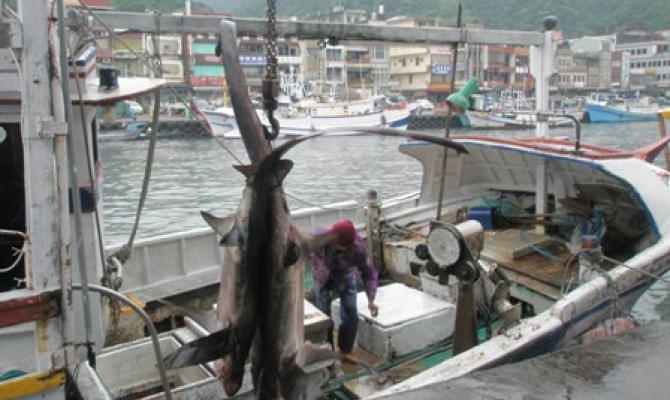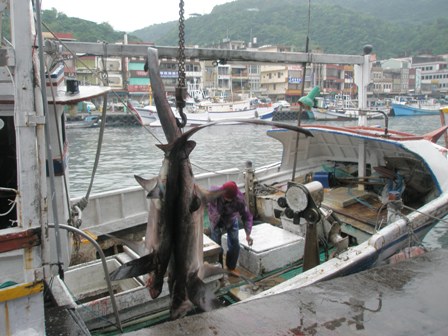
General News
4 December 2014, Apia, Samoa - The Director General of the Secretariat for the Pacific Regional Environment Programme (SPREP) has called on the members of the Western Central Pacific Fisheries Commission (WCPFC) meeting being held in Apia this week to pay greater heed to the by-catch of protected species such as sharks and turtles in Pacific islands fisheries.
"While Commission members are understandably focused on the sustainability and equitable allocation of the Pacific's tuna resources at this week's Commission meeting, there is also a need for urgent action to protect the region's threatened marine species that are impacted by fishing operations," said David Sheppard today.
"Whales, dolphins, turtles and sharks are iconic species, and they provide an increasing and economically valuable niche for Pacific island countries in the growing ecotourism market. However, the populations of many species of cetaceans, turtles and sharks in the region are at historically low levels, and are threatened from by-catch from commercial fishing."

Long liner vessel offloading sharks at seaport in Taiwan
Mr Sheppard noted that the regional concerns about depletion of shark populations through fishing activities have been reflected by the establishment of shark sanctuaries in many countries, and the introduction of bans on shark finning in the Exclusive Economic Zones (EEZ) of other Pacific island nations. He also commended the leadership role taken by Cook Islands, Palau, Vanuatu and Samoa in signing the Convention on Migratory Species MoU on migratory sharks.
“SPREP has been working closely with several of its member countries, all of whom are Commission members, to improve the protection afforded to a number of shark species in the region through both the Convention on Migratory Species and the Convention on International Trade in Endangered Species."
The Republic of Palau's Director of the Bureau of Oceanic Fishery Management, Nannette Malso, commented: "The region's tuna fisheries significantly impact a number of vulnerable shark species and Palau would like to see this effectively addressed by the Commission. There are numerous studies of the main mitigation measures, such as banning wire traces and the use of squid for bait, that demonstrate significant reductions in shark catches but a few Commission members are hesitant to adopt these best practices. The Palau Shark Sanctuary bans the retention by the commercial tuna fishery of sharks and rays, including their fins. This likely reduces their fishing mortality, since a large proportion of these species are alive upon release."
Mr Sheppard urged the Commission to increase observer coverage on the 3,000 or more longline fishing vessels in the Pacific Islands region, noting that this coverage is currently very low. He said that, notwithstanding the poor observer coverage, analyses conducted by the Secretariat of the Pacific Community and WCPFC make it clear that pelagic sharks have been heavily over-fished in recent years, especially silky sharks and oceanic white-tips, which are currently at a small fraction of their former abundance.
Ian Campbell from WWF’s Global Shark & Ray Initiative stated that the lack of information available is a particular concern. “For the species where we have some data, such as silky and oceanic whitetip sharks, the situation is dire, yet we still don’t know the full extent of the problem as many countries, especially those that send vast fleets to the Pacific, simply don’t provide any data in the form of catch reports.”
Mr Sheppard also expressed his concerns about the potential impact of drifting Fish Aggregating Devices (FADs) on protected species, particularly turtles and stressed the need for urgent action. He noted:
"A presentation earlier this week by the Parties to the Nauru Agreement estimated that between 30,000 and 80,000 FADs are now drifting around in the Pacific islands region.
Each FAD has a large amount of netting hanging in the water which attracts fish and other marine creatures, and can be a trap for turtles. Additionally turtles can easily become entangled by their claws if they try to climb up onto the FAD. The proportion of turtles that come into contact with FADs and are able to swim away and those that become permanently entangled is currently unknown, but it's not unreasonable to suppose that many turtles - perhaps hundreds or even thousands - are trapped and die in drifting FADs each year. Unfortunately, this year's meeting of the Scientific Committee did not receive any information on turtles, and there is no data at all on the impacts of drifting FADs on turtle populations in the Pacific islands. I hope that the Commission will urgently look into this matter."
And further noted:
"We are hopeful that the Commission will this week agree to pass a new Conservation Management Measure that will effectively address the problem of shark by-catch and targeted catch in both longline and purse-seine fisheries. SPREP is also committed to working with the Commission, other regional agencies and stakeholders to better understand the extent and significance of by-catch of turtles, seabirds and cetaceans in both longline and purse-seine fisheries, and to the development of mitigation measures," he said.
-----------ENDS----------------
"While Commission members are understandably focused on the sustainability and equitable allocation of the Pacific's tuna resources at this week's Commission meeting, there is also a need for urgent action to protect the region's threatened marine species that are impacted by fishing operations," said David Sheppard today.
"Whales, dolphins, turtles and sharks are iconic species, and they provide an increasing and economically valuable niche for Pacific island countries in the growing ecotourism market. However, the populations of many species of cetaceans, turtles and sharks in the region are at historically low levels, and are threatened from by-catch from commercial fishing."

Long liner vessel offloading sharks at seaport in Taiwan
Mr Sheppard noted that the regional concerns about depletion of shark populations through fishing activities have been reflected by the establishment of shark sanctuaries in many countries, and the introduction of bans on shark finning in the Exclusive Economic Zones (EEZ) of other Pacific island nations. He also commended the leadership role taken by Cook Islands, Palau, Vanuatu and Samoa in signing the Convention on Migratory Species MoU on migratory sharks.
“SPREP has been working closely with several of its member countries, all of whom are Commission members, to improve the protection afforded to a number of shark species in the region through both the Convention on Migratory Species and the Convention on International Trade in Endangered Species."
The Republic of Palau's Director of the Bureau of Oceanic Fishery Management, Nannette Malso, commented: "The region's tuna fisheries significantly impact a number of vulnerable shark species and Palau would like to see this effectively addressed by the Commission. There are numerous studies of the main mitigation measures, such as banning wire traces and the use of squid for bait, that demonstrate significant reductions in shark catches but a few Commission members are hesitant to adopt these best practices. The Palau Shark Sanctuary bans the retention by the commercial tuna fishery of sharks and rays, including their fins. This likely reduces their fishing mortality, since a large proportion of these species are alive upon release."
Mr Sheppard urged the Commission to increase observer coverage on the 3,000 or more longline fishing vessels in the Pacific Islands region, noting that this coverage is currently very low. He said that, notwithstanding the poor observer coverage, analyses conducted by the Secretariat of the Pacific Community and WCPFC make it clear that pelagic sharks have been heavily over-fished in recent years, especially silky sharks and oceanic white-tips, which are currently at a small fraction of their former abundance.
Ian Campbell from WWF’s Global Shark & Ray Initiative stated that the lack of information available is a particular concern. “For the species where we have some data, such as silky and oceanic whitetip sharks, the situation is dire, yet we still don’t know the full extent of the problem as many countries, especially those that send vast fleets to the Pacific, simply don’t provide any data in the form of catch reports.”
Mr Sheppard also expressed his concerns about the potential impact of drifting Fish Aggregating Devices (FADs) on protected species, particularly turtles and stressed the need for urgent action. He noted:
"A presentation earlier this week by the Parties to the Nauru Agreement estimated that between 30,000 and 80,000 FADs are now drifting around in the Pacific islands region.
Each FAD has a large amount of netting hanging in the water which attracts fish and other marine creatures, and can be a trap for turtles. Additionally turtles can easily become entangled by their claws if they try to climb up onto the FAD. The proportion of turtles that come into contact with FADs and are able to swim away and those that become permanently entangled is currently unknown, but it's not unreasonable to suppose that many turtles - perhaps hundreds or even thousands - are trapped and die in drifting FADs each year. Unfortunately, this year's meeting of the Scientific Committee did not receive any information on turtles, and there is no data at all on the impacts of drifting FADs on turtle populations in the Pacific islands. I hope that the Commission will urgently look into this matter."
And further noted:
"We are hopeful that the Commission will this week agree to pass a new Conservation Management Measure that will effectively address the problem of shark by-catch and targeted catch in both longline and purse-seine fisheries. SPREP is also committed to working with the Commission, other regional agencies and stakeholders to better understand the extent and significance of by-catch of turtles, seabirds and cetaceans in both longline and purse-seine fisheries, and to the development of mitigation measures," he said.
-----------ENDS----------------